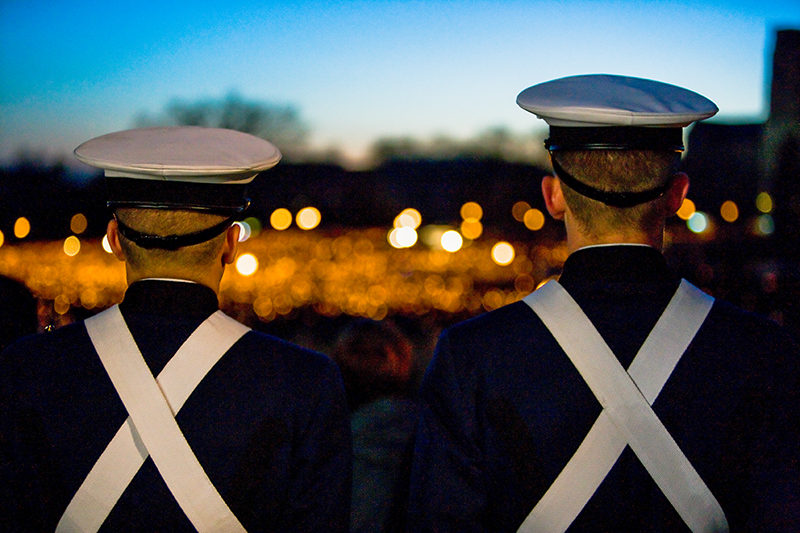That night, April 17th, 2007, just a day after the massacre, I sat alone on the low wall that circumscribes the Virginia Tech War Memorial waiting for my brother, Richard. Behind me, one of the many TV crews was still breaking down its equipment. Dan Rather had broadcast his coverage of the day’s events just a few steps from where I sat, my back to one of eight massive limestone pylons. Each bore its own theme carved into it: Brotherhood, Honor, Leadership, Sacrifice, Service, Loyalty, Duty, and Ut Prosim—That I May Serve (our university motto). The wall around them had been my retreat as an undergraduate twenty years before when I needed a quiet place to shut out the world. That evening, I returned.
I’d been numb since the previous morning when word first broke and the death toll mounted. The revelation of the shooter’s identity hollowed me out further. He’d been one of ours, a student writer in the department of English. My fellow teachers had tried to encourage his voice, but silence was his muse. Language had failed us. I know words can’t deflect bullets, but they are my only armor. They saved me that day in the face of so much sorrow.
I looked out from my perch over the emptied heart of campus known as the Drillfield, a 22-acre ovoid of grass and well-lit pathways. On any given school day, it’s a blur of motion, students streaming across it from dorm to class and back again. Our corps of cadets still use it for parade, its primary purpose when the land was first set aside by the university in 1894. It’s been the hub of activities from concerts and picnics to touch football and snowball fights. Hours before, thousands of us had gathered here for the candlelight vigil to mourn our recent dead and wounded.
As Richard and I had arrived on scene, a volunteer handed me a simple white candle stuck through the base of a waxy red Coca-Cola cup. Another had tipped her lit wick to mine, kissing it to life. I’d passed on the flame touching it to another and another, each subsequent kiss spreading light amongst us like summer fireflies in the hayfields around my home. I pressed deeper into the warmth of the swelling crowd. There were tears, but there was love, so much love.
All around me, students held each other close, hugged those who wept. They were quiet, but not silenced; they humbled me. I drew strength from them and finally my own words came like tears. Amid the quilt of guttering candles, I embraced my friends, students, and fellow faculty and together we wrote a new line of our story. The cool wind kept snuffing candles, but we pulled them deeper into our cups and lit them once more.
I still didn’t know if any faces would be missing when I returned to class. I had wanted to stay home, but my brother insisted we go. I finally decided to follow him though planned to shy from the spectacle of organized grief. But here we were, the cameras of every broadcaster in the world trained on us as we raised our fire to mirror the stars. I knew Richard was somewhere in the darkness beyond us, pacing with his own lens, compelled to bear witness by capturing our constellation of candlelight.
As a teenaged freshman, I once sauntered blithely across this very spot in moccasin slippers and a blue terrycloth bathrobe. I was on my way to an early morning English class I couldn’t quite be bothered to get dressed for. It never occurred to me that I risked anything more by going to class than a raised eyebrow from my bemused professor. I felt the same upon my return fifteen years later on the other side of the desk. Now, I long for those drab and familiar classrooms before electronic emergency signs, peepholes, and locking doors transformed them. I wish I couldn’t see brightly colored posters full of instructions on what to do in a lockdown.
In the aftermath of the vigil, I found some measure of peace. Somewhere in the shadows below me, a lone bagpiper struck up Amazing Grace, as if on cue. I closed my eyes and leaned back against the rough stone slab of Sacrifice, surrounded by the names of our students killed in battle. Deep in my jacket pocket, I could feel the slim white candle still warm where it had burned all too briefly.
The Kiss is a bimonthly series curated by Brian Turner.
The Kiss: Intimacies from Writers is available from Norton in February 2018.
